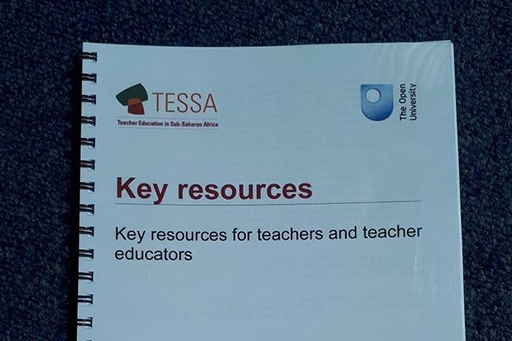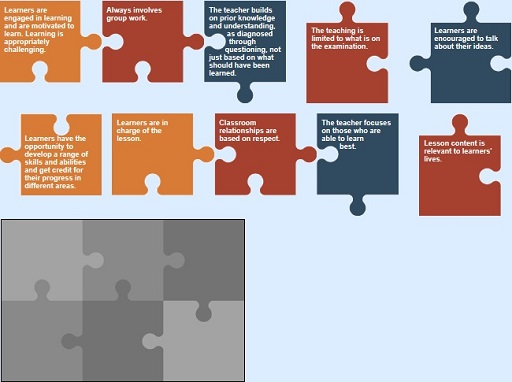Use 'Print preview' to check the number of pages and printer settings.
Print functionality varies between browsers.
Printable page generated Friday, 21 November 2025, 7:42 PM
Section 2: Active teaching and learning and learner-centred education
Introduction
This section focuses on learner-centred education (LCE) and active learning. What does active teaching and learning mean in practice? How do teachers and teacher educators learn new techniques?
The ten activities in this section will help you understand how to use active teaching approaches in your own practice. You will be provided with tools and examples that you can use to help you develop into a more effective teacher educator.
You will start with thinking about what LCE means to you and then complete a quiz that addresses some of the common misconceptions about LCE. You will think about what teachers need to know about active learning and how to teach their subject, and therefore what you as a teacher educator need to know and to be able to do.
Activity 2.1: Active teaching and learning and LCE 
Many African policy documents set out an expectation that learners will be ‘actively engaged’ in learning, and some specifically mention LCE.
What do you understand by the term LCE? Write down your ideas in your study notebook.
- Write a short statement by completing the following sentence: ‘LCE is important because…’.
- Do you think your current style of teaching is learner-centred? What are the reasons for your answer?
In the next activity you are asked to complete a quiz, which comprises of statements about LCE. These statements are based on some of the common misconceptions about LCE. You will be asked to indicate whether you think each of the statements is true or false. The quiz is important because it will help you to think deeply about what LCE really means.
Activity 2.2: True or false on LCE?
What do you know about LCE? Try this quiz to check your learning. Your score here will go towards your final certificate and badge for completing the course.
You may like to use a downloadable version of this quiz with teachers or student teachers.
You could do the activity as Think, Pair, Share. This is a very powerful technique because it allows learners to talk about their ideas; it provides a safe space for them to test their thinking and get feedback; and as a teacher if you move around the room while they are discussing their answers you will find out who needs more support and who understand the work.
- Think: Teachers complete the activity on their own. Encourage them to try to answer as quickly as they can to avoid over-thinking their responses.
- Pair: Teachers talk over their responses with a colleague. Which of their answers were the same? Which were different? Each pair shares their agreed answers with another pair.
- Share: As they talked through the reason for their answers and listened to their colleague(s), did they change their mind about any of the statements?
Reflecting on learner-centred education

The correct answers to the quiz in Activity 2.2, highlight the fact that it is helpful to think of ‘learner-centredness’ as a set of attitudes and values. Here is a set of questions you could use to decide if your teaching is ‘learner-centred’. (These are based on a set of ‘minimum standards’ for LCE suggested by Michele Schweisfurth (2013), p. 146).
- Are students engaged and motivated to learn?
- Are classroom relationships based on mutual respect?
- Does the learning challenge students and build on their existing knowledge?
- Are students given the chance to talk about their ideas to support their learning?
- Is the curriculum relevant to learners’ lives? Do the activities promote a range of skills including critical thinking and creativity?
- Does the assessment test a range of skills and give credit for more than recall of knowledge?
These could apply to teachers working with students, or to teacher educators working with teachers and student teachers. At the heart of LCE is the relationship between the teacher and the learner. You can print out a copy of these criteria if you wish to monitor your own teaching or that of your student teachers.
LCE is often associated with particular classroom approaches. However, this is misleading. Badly organised group work with an inappropriate task, for example, is worse than the alternatives. It won’t lead to learning and is not ‘learner-centred’.
Activity 2.3: Reflecting on learner-centred education 
The quiz in Activity 2.2 highlights some common misconceptions about LCE. What did you learn from the quiz? What surprised you? Make a note of your response in your study notebook.
Next, think about the last teaching session that you had with teachers or student teachers. Use the criteria above to reflect on how you could have made it more learner-centred. Write down three ideas in your study notebook. If possible, discuss your ideas with a colleague.
A UNESCO report for teacher educators, called Ensuring Quality by Attending to Inquiry: Learner-centred Pedagogy in Sub-Saharan Africa, highlights some of the challenges of LCE. The report is available for you to read through if you wish.
The authors make the point that implementing LCE is complex and that local, contextually relevant solutions are required. This means it is important for teachers and teacher educators to work together to understand how to improve their practice.
Teaching approaches
Teachers and teacher educators have found it easier to build a different sort of relationship with learners by using strategies which promote active engagement such as:
- flexible use of whole-class, group and pair work where students discuss a shared appropriate task;
- frequent and relevant use of learning materials beyond the textbook;
- open and closed questioning, expanding responses, encouraging student questioning;
- demonstration and explanation, drawing on their knowledge of how to teach different topics;
- use of local languages, code switching (moving between two languages) and translanguaging (drawing on multiple languages);
- planning and varying lesson sequences.
Using ICT can also help build more democratic relationships, by creating more opportunities for talking about learning, and for learners to ask questions.
It has been reported by teachers and teacher educators that employing these strategies over time leads to a transformation in relationships with their students. By changing their teaching methods to focus on active learning they noticed the ‘visible response in their students that indicated that learning was taking place’ (Westbrook et al., 2013).
Activity 2.4: Analysing teaching 
Stories or case studies can help to make the concepts of LCE, active teaching and learning and assessment more tangible and real for teacher learners. In this activity you will read an example of a case study from the TESSA materials and consider what can be learned from it.
Read the following case study from a Literacy OER: Literacy, Module 3, Section 3, Case Study 3:
Mrs Ndaba’s Grade 6 class had brought stories from home and illustrated them. On each page, they had written a sentence and drawn a picture to match it. The pages had been tied together to make books.
Her colleague, Ms Mdlalose, who taught the Grade 3s, had seen the illustrated stories, and asked to borrow them for a reading activity with her pupils. Mrs Ndaba came and watched.
Ms Mdlalose divided her class into five groups. She gave each group a story, but she untied the pages and put them in the middle of the table. She then gave each pupil in the group one page of the story, making sure that she mixed the order of the pages. Each pupil had to read the sentence on their page to the group. Through discussion, the group decided which sentence came first in the story, put all the sentences in order and put the pages back into the file in the correct order.
Ms Mdlalose asked one pupil from each group to read their group’s story to the class and they commented about the order. As a class, they selected their favourite story and a five-minute drama was organised to perform this story.
This case study highlights some of the different strategies that teachers can use to promote active teaching and learning. In your notebook:
- Identify three different strategies that Ms Mdlalose used to promote active teaching and learning.
- List the skills that Ms Mdlalose needs to organise this lesson.
This case study also highlights where the teacher can give formative feedback to her students.
- What opportunities are there for Ms Mdlalose to find out more about her students’ learning?
- What sort of feedback could she provide?
Case studies are useful examples to share with student teachers.
- How could you use this activity with your student teachers?
- How might a laptop and a projector help you?
This lesson promotes thinking skills through a sequencing exercise. This is a useful technique for a teacher to test understanding, for students to have a meaningful discussion and for students to practise logical thinking.
Write down another example in your notebook from a different subject that could be used as a sequencing exercise. If you can, share your ideas with a colleague.
TESSA Key Resources

The TESSA ‘Key Resources’ summarise some of the teaching approaches that you and your teachers will find helpful. They provide a framework for teacher development.
Activity 2.5: TESSA Key Resources 
Open the document ‘TESSA Key Resources’ and look through the contents page. Choose one or two resources to read in more detail.
- How could you use the Key Resources with your student teachers? If each student had them available on a mobile phone, how could you capitalise on this?
- Are there any Key Resources which you could use to plan your own teaching? Think about the topics that you will be teaching in the near future.
- Write a plan in your study notebook which draws on or uses one of the Key Resources. Note which Key Resource you would use and how you would use it.
Knowledge of how to teach
One of the challenges for teacher educators is to help student teachers learn how to teach specific topics. Some courses have specific subject methodology sessions. Sometimes, however, student teachers are taught the subject in a different department from the methodology. For example, they might be taught fractions by a maths lecturer and different classroom approaches by an education lecturer.
The TESSA Subject Resources, although linked to curriculum topics, are not age specific. This is because they are not designed to be prescriptive lessons plans; rather they are a tool that teachers can use to plan their lessons. Also, they enable you to teach subject knowledge and pedagogical knowledge at the same time, thus deepening your own understanding of teaching. This is known as ‘pedagogical content knowledge’ (PCK) (Shulman, 1986).
PCK is special to teachers – it describes the knowledge that teachers have about how to teach their subject. It involves knowing the subject, knowing about pedagogy, and knowing how to represent ideas about the subject to learners.
Activity 2.6: Knowledge of how to teach 
Open the TESSA unit on teaching fractions. (You can also download a PDF version of it.) You will notice that there are three activities, three case studies and a set of resources to support the activities. The learning outcomes are for the teacher.
- How could you use the TESSA unit to support the teacher in improving their practice? Write down your ideas in your study notebook.
If you have the opportunity, ask your student teachers to use the unit to plan a lesson suitable for younger children and a lesson suitable for older children.
- How do your students develop their PCK? Write down a few ideas in your study notebook and discuss them with a colleague.
Thinking about teacher education programmes
TESSA Subject Resources provide support on how to teach topics that are part of the school curriculum. In the next activity you have the chance to reflect on how they might be integrated into the teacher education and professional development programmes that you work on.
Activity 2.7: Teacher education 
Download the handbook Working with Teachers. Look at some of the examples of how teacher educators have used TESSA OER in their work.
Find two or three ideas that would work in your context.
How will you use TESSA OER to support your teacher learners? List your ideas in your notebook.
Making teacher education pedagogy more interactive
Most of the TESSA OER are linked to the school curriculum. It is relatively easy to see how they can be used to support micro-teaching, teaching practice, subject teaching and teaching methods.
However, many teacher educators spend a considerable amount of time on ‘professional studies’ – child psychology, the sociology of education, learning theories, etc. How these topics are taught also matters. Your students are just as likely to remember how you teach them as what you teach them. Remember, in teacher education ‘the medium is the message’.
Activity 2.8: Interactive teacher 
Read the case study ‘Teaching the sociology of education’ about how a teacher educator changed her own practice.
Think about a teaching session that you ran recently. How could you make the session more interactive? Draw on the case study, the TESSA Key Resources and, if appropriate the subject OER for some ideas. Could you use ICT to help?
Your session does not need to be as radical as Anne’s approach – very small changes to the type of questions you ask or using pair work can make a difference. For instance, think of ways you can move away from simply dictating notes or giving a lecture as these are likely to be passive from a learner perspective.
Identifying your professional needs
The issues that classroom teachers face in changing their practice apply to teacher educators too. For example, more time will need to be spent on planning for active learning. Collaborating with colleagues – such as through joint planning, observation and reflection – can be very beneficial.
The School Experience Toolkit contains a section about TESSA OER and how to use TESSA with teachers and student teachers. You might find it helpful to download the section and use it for reference when you are planning your teaching.
As part of planning your own professional development, you need to identify your current skills and the ones you need to develop. A skills audit is a useful starting point.
Activity 2.9: A skills audit
Complete the TESSA teacher educator audit of ‘Skills to support active participation in learning’ which is available as either a Word file or a PDF. Identify three skills that you want to focus on first.
Use the TESSA ‘Personal action plan’ template (available as either a Word file or a PDF) to record your development priorities and what actions you will take to develop them.
For example, you might plan to gain experience of these through practice in your teaching, asking a colleague for feedback or doing some additional reading.
Not only will the audit and action plan help you to reflect on your current practice and goals, but they are also tools that you can use to monitor your development over the next few months.
An overview of learner-centred education
You have considered different aspects of LCE in this section. The next activity revises the key ideas.
Activity 2.10: LCE jigsaw
Click on the image below to try the jigsaw puzzle, which summarises key ideas about LCE.
Moving forward
This section has focused on LCE, how to model active pedagogy yourself, and how to support pre-service and in-service teachers in developing active approaches to learning, through the feedback you provide and by exposing them to new ideas.
Changes in practice take a long time to embed. Start by making a few small changes to your practice – such as using pair-work or planning to use different types of questions. As you become more confident (and learn from your mistakes) you will become more adventurous.
In Section 3 the focus will be on using Information Communication Technology (ICT) to enhance learning. You will need to think about the technological skills required, and the sorts of classroom approaches that you can use. You will need to examine any suggestions about how ICT could be used, critically to ensure that it really does enhance learning.
